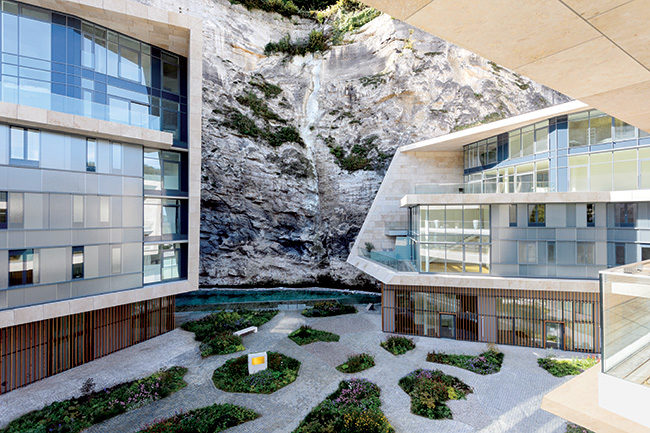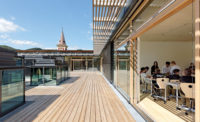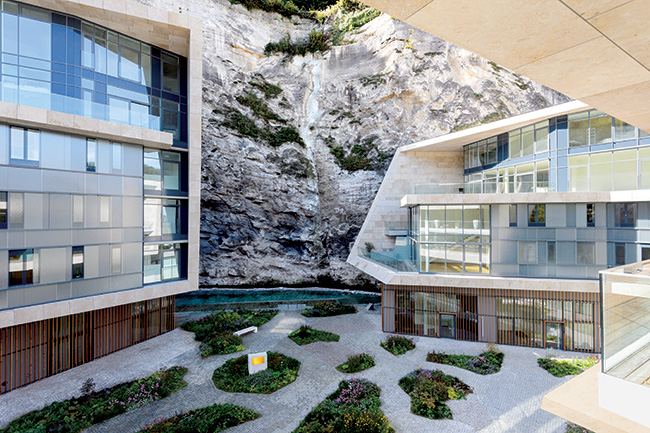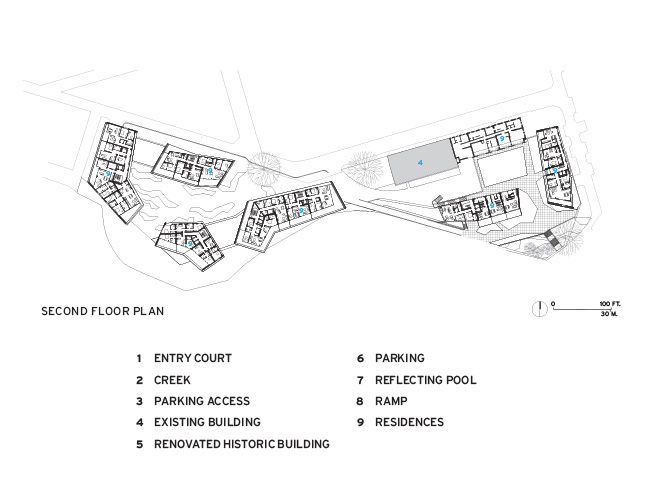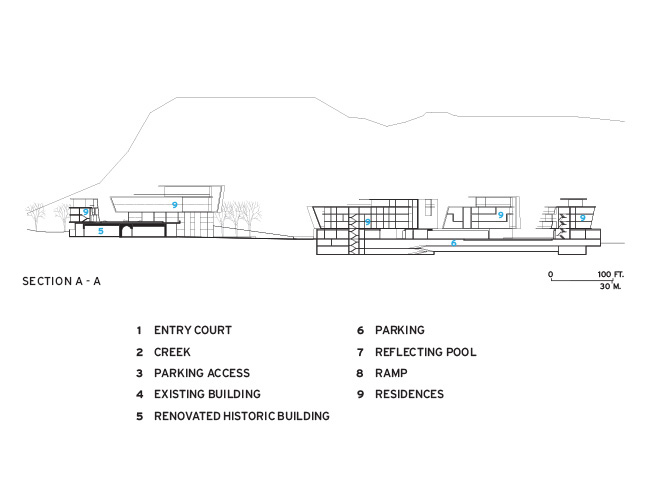Salzburg, Austria
An abandoned sandstone quarry on Rainberg Mountain, above the historic city of Salzburg, Austria, is hardly the place one would expect to find a desirable urban neighborhood. But, nevertheless, that’s where developer Asset One decided to build 100 units of housing.
When New York–based architects Gisue and Mojgan Hariri first visited in 2006 in response to an invited competition, they found the site “derelict and magical.” Known as the Sternbrauerei, the quarter was dominated by the quarry’s soaring rock face to the west but also contained a defunct landmarked brewery and its storage vaults. Nineteenth-century villas and more recent low-rise apartment buildings border the northern edge, while a forest rises to the south.
The jury selected the Hariris’ scheme because it sensitively integrated new buildings into the spectacular topography. “We realized immediately that we had to respect the rock,” says Gisue Hariri. They designed six blocks ranging from three to six stories in height, containing units that vary from 650 to 3,000 square feet. Each building has a distinct crystalline form, like giant stones that were hewn from the mountain. Completed late last year for developer UBM, which took over the project in 2010, the complex allows residents to bask in nature and experience an unusual public space.
The Hariris arranged their faceted structures to create two courtyards linked by an elongated plaza and built over two levels of underground parking. To the east, to enclose a grass-covered courtyard, two of the blocks join the old brewery, which has been converted to residences as part of the project. Apartments and offices occupy the storage vaults, which lie below the courtyard. To the west, four more blocks surround the second courtyard, which is landscaped with beds of perennials and opens to the rock face and a creek constructed as a water feature. An adjacent street and a mountain path provide access to the plaza, and from there anyone can wander through. “We wanted to make a real neighborhood and not a gated community,” says Gisue Hariri.
The individual buildings differ slightly in size and shape, but share a formal language. Each includes a continuous folded plane of reinforced concrete clad in limestone, which has an affinity with the quarry face even though it is not the same type of rock. (Sandstone was originally selected, but its high absorption rate would have necessitated much thicker veneer panels.) The plane covers the roof and bends to form both vertical walls and floor decks, wrapping the upper portion of the building. This dynamic element cantilevers over a mostly glass-enclosed base shielded with a delicate screen of vertical larch strips.
The apartment units feature an array of layouts in response to the developer’s request for three housing types—small ateliers for artists, single people, and couples; one- to three-bedroom apartments for families; and spacious penthouses intended to appeal to both local and international buyers.
Duplex, studio, and one-bedroom atelier units, with 16-foot-high interiors, occupy the ground floor and are accessed directly from the courtyards. Entrances at the courtyard and street, and from the garage, lead to vertical circulation cores that serve the midsection units and penthouses. These generally have more typical floor-to-ceiling heights.
While their size and configuration vary, most of the units at the buildings’ ground and middle floors have open kitchen-living-dining areas with floor-to-ceiling glazed facades, and terraces with glass balustrades that permit seamless views to a courtyard, the forest, or the rock. In the middle floors, hallways, baths, and bedrooms are placed along a concrete wall with punched windows that face either north or east and provide framed views of the environs. Clear and translucent glass panels sheathe this concrete wall on the exterior, completing the blocks’ vitreous appearance.
The one- and two-story penthouses also have continuous, but much more expansive, living-dining-kitchen spaces. Floor-to-ceiling glass and deep wraparound terraces open the apartments to panoramas of the city and the mountain. To maintain comfort throughout the long alpine winter, all units have triple-glazed facades and an under-floor heating system.
Just as each apartment presents residents with a slice of nature, the Steinbrauerei offers all an uncommon oasis, even though it is now a dense urban quarter with about 250 residents, 90 percent of whom live there full-time. On a recent visit, their belongings—bicycles, furniture, and greenery on the terraces—were in evidence. But despite this clutter, the complex provides a sanctuary, with the silence of the mountain giving way to the sound of birdcalls and the rushing water, with perennials blooming and moss creeping along the creek. In this setting, the rock-inspired buildings seem more like a part of the landscape than a piece of the city.
As a response to this unique context, the architecture invites associations: the larch strips resemble forest saplings, and the irregular glazed blocks recall not only the site’s stone but the translucent, jewel-like quartz that is common in this region. “The challenge,” reflects Gisue Hariri, “was to make it cost-effective and sufficiently unconventional without creating an unwarranted intervention in this magical setting.” The Hariris have succeeded with skill and imagination; here one truly leaves the city and makes the transition to nature.
Size: 95,000 square feet
Cost: withheld
Completion date: September 2014
People
Client: Asset One Immobilienentwicklungs - Original Developer Owner: UBM Realitätenentwicklung AG
Architect:
Personnel in architect's firm who should receive special credit:
Architect of record:
Associate architects:
Engineers
Mechanical:
Electrical:
Building Physics:
Consultant(s):
Lighting:
Acoustical:
Building services:
General contractor:
Photographer(s):
Interiors of Penthouse C12: |
Products
Structural system
Exterior cladding Metal/glass curtain wall: Schüco FW50+HI, aluminum profile facades Wood: Larch, Karo Metall GmbH (Schorfling am Attersee), ALU-SOMMER GmbH (Stoob, Osterreich) Moisture barrier: Bitouminous sealing Curtain wall: Schüco FW50+HI Other cladding unique to this project: Limestone, Jura, Germany
Roofing Tile: Limestone, Jura, Germany
Windows
Glazing
Doors
Hardware
Interior finishes (common areas)
Lighting
Conveyance
Add any additional building components or special equipment that made a significant contribution to this project: Water: To create a dialogue and a personal, meditative experience we have cut a narrow creek at the edge of the rock wall, which guides and invites the public through the site. Just like the Salzach River, it creates a new boundary, provides movement and extends the nature into the site. An old path is incorporated in this sequence where the water travels from the highest elevation on the site and becomes the collector of melting snow water, icicles, and rocks. This water creek also provides a place for exhibition of outdoor water sculptures, a spiritual space for meditation and for the public to enjoy the natural beauty of the forest and the rock face without disturbing the privacy of the residents. |


